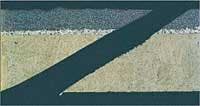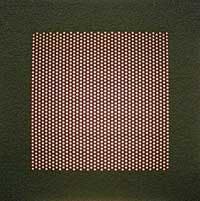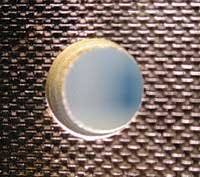Are excimer lasers the ultimate drillers?
Excimer lasers are gaining ground on Nd:YAG lasers in drilling ceramic coated surfaces and stacks of composite material and in opening the structure of honed cylinder surfaces
Martien van Dijk
Drilling was one of the first industrial applications of lasers in material processing, with ruby lasers being the choice because of their spiky output characteristics. Today the pulsed Nd:YAG laser is the workhorse that is used to drill a large number of holes.
Laser drilling is a niche technology used mainly in drilling of film cooling holes in gas turbine components such as blades, vanes, combustion liners, after burners, and components like fuel diesel injection nozzles and dies for wire extrusion. Although laser drilling is fast, it has to compete with Electric Discharge Machining (EDM), because the recent developments of high-pressure oil supply through rotating hollow electrodes and linear motors have improved the drilling speed of EDM significantly, such that this process is outperforming laser drilling on quality.
The advantage of laser drilling over EDM is the laser’s independence on the electrical conductivity of the material. However the heat input may be relatively high, which makes the laser process less suited for drilling of ceramic coated components.
Pulsed lasers are normally used for drilling applications. The average power is given by the relation:
Pavg = Pp * tp* νp
Where:
Pp = peak power [kW]
tp = pulse length [ms]
νp = pulse frequency [Hz]
For a given average power there is an infinite number of combinations of peak power, pulse length, and pulse frequency possible, with at least one combination that will give optimum process results. A very long pulse will result in a low peak power such that the material will only be heated with melting and little removal of material. At very short pulse lengths and low frequency the peak power will be very high but, due to the short interaction time, only a very thin layer of material will be removed by ablation. A simple method to find the optimal parameter combination is given in reference 1.
null
Excimer lasers for drilling
Due to their shorter wavelength, compared to Nd:YAG lasers (see the table), the radiation of an excimer laser will be better absorbed by metals than the radiation of a Nd:YAG laser. The shorter wavelength makes the excimer laser well suited for drilling of holes with small diameter. However in drilling of small holes removal of material may become a limiting factor.
Traditional excimer lasers have pulse lengths in the range of 10 to 20 ns. In a study on the effect of the pulse length on the efficiency and quality of drilling, Schoonderbeek2 used a XeCl laser to drill 125µm-thick aluminum and found that long pulses (104 ns) with high peak power (15 kW) gave the best hole quality (see Figure 1). He also found that the efficiency of one single 104ns pulse is more efficient than 12 pulses of 9 ns with the same cumulative energy (see Figure 2).
The difference in efficiency may be explained by realizing that the heat has to be transferred from the surface into the material. Another finding of this research is that the material is flowing out of the hole even after the laser’s pulse is ended. For a 0.65mm thick plate Hasteloy X the removal of the material ended after 0.1 ms, which is typically 100 times longer than the pulse length. On the other hand the pulse length is short compared to the pulse lengths used in traditional Nd:YAG laser drilling so the heat affected zone will be very small. At the same time the power density will be higher. Therefore more material will be removed in the vapor phase, which results in reduction of the thickness of the recast layer. All these effects lead to a better quality of the drilling process.
Beam profiling
In general, holes to be drilled will have a cylindrical cross section but the raw beam of an excimer laser has a rectangular shape. A simple method to drill round holes is to use a mask. A lens or a set of lenses will be used to image the mask on the surface of the material to be drilled. The disadvantage of this approach is that only a part of the laser energy is used; in many cases only 30 percent or less of the optical beam power is used. A more efficient method to profile the beam is the use of holograms to focus the beam as demonstrated by Biesheuvel3, which can result in an efficiency of 90 percent. By using a hologram one may also create different beam shapes. Drilling multiple holes is possible by using holographic beamsplitters, and it is also possible to create a ring-shaped beam to drill holes with large diameters.
Applications in drilling
When laser drilling ceramic coated surfaces, the Nd:YAG laser struggles with the problem of de-lamination of the coating. The excimer laser, thanks to its short pulse length, is capable of drilling through the coating without the risk of de-lamination (see Figure 3).
Excimer lasers are also well suited for drilling through stacks of composite material, for example Carbon Fiber Composites (CFCs), due to the short wavelength that results in high photon energy. Figures 4 and 5 give examples of holes drilled in CFCs. The diameter of the holes in Figure 4, used in acoustic damping panels, is 0.2 mm.
Another application is opening the structure of honed cylinder surfaces by ablation, where the open structure improves the tribological properties of the surface and reduces wear (see the October 2004 issue of ILS).
High-power excimer laser drilling, with pulse lengths in the range of 100-200 ns, is becoming of interest where pulsed Nd:YAG laser drilling suffers in hole quality. The heat affected zone will be smaller and the recast layer will be thinner by selection of the proper parameters.
References
- M.H.H. van Dijk, “Pulsed Nd:YAG laser cutting,” The Industrial Laser Annual Handbook, 1987, pp 52-65.
- A. Schoonderbeek, C.A. Biesheuvel, R.M. Hofstra, K.-J. Boller, J. Meijer, “The influence of the pulse length on the drilling of metals with an excimer laser,” Journal of Laser Applications, vol.16, nr2, pp. 85-91, 2004.
- C. Biesheuvel, E.A., High speed parallel laser drilling with a high power excimer laser, ICALEO 2004.
About NCLR
NCLR is located in the town of Enschede in the Netherlands. The company has developed an excimer laser, the Sirius 1000, with an average power of 1kW. The long pulse length (200 ns) makes the laser well suited for drilling. The beam may be focused to a spot as small as 10 µm resulting in a power density of 10TW/cm2. This high average power makes it possible to drill multiple holes. The company designs and manufacturers special holographic beamsplitters with optical efficiencies of 90 percent or higher. The facilities of the Twente University are used to produce these devices. Find more information on its website: www.nclr.nl.






